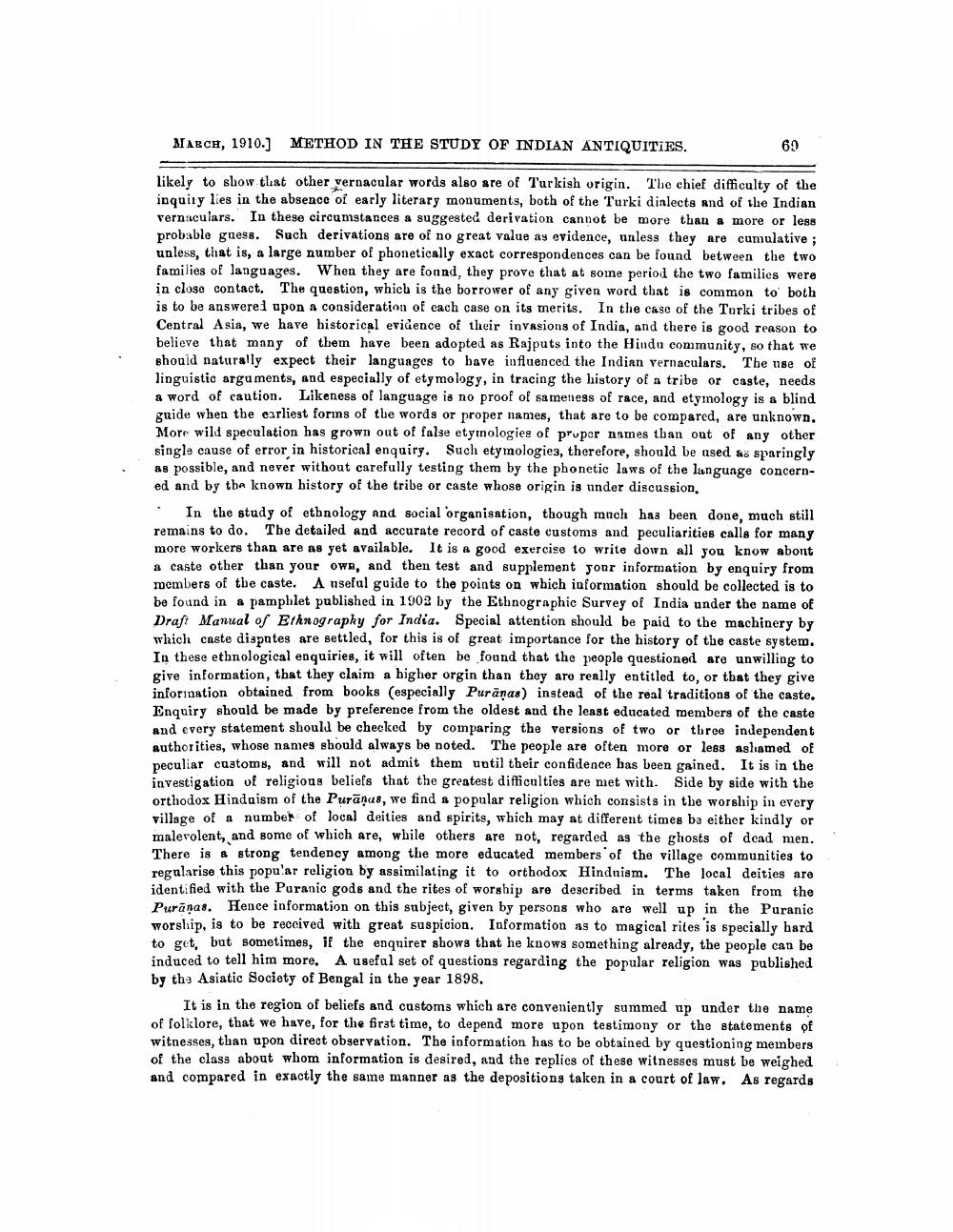________________
69
MARCH, 1910.] METHOD IN THE STUDY OF INDIAN ANTIQUITIES.
likely to show that other vernacular words also are of Turkish origin. The chief difficulty of the inquity lies in the absence of early literary monuments, both of the Turki dialects and of the Indian vernaculars. In these circumstances a suggested derivation cannot be more than a more or less probable guess. Such derivations are of no great value as evidence, unless they are cumulative; unless, that is, a large number of phonetically exact correspondences can be found between the two families of languages. When they are found, they prove that at some period the two families were in close contact. The question, which is the borrower of any given word that is common to both is to be answered upon a consideration of each case on its merits. In the case of the Turki tribes of Central Asia, we have historical evidence of their invasions of India, and there is good reason to believe that many of them have been adopted as Rajputs into the Hindu community, so that we should naturally expect their languages to have influenced the Indian vernaculars. The use of linguistic arguments, and especially of etymology, in tracing the history of a tribe or caste, needs. a word of caution. Likeness of language is no proof of sameness of race, and etymology is a blind guide when the earliest forms of the words or proper names, that are to be compared, are unknown. More wild speculation has grown out of false etymologies of proper names than out of any other single cause of error in historical enquiry. Such etymologies, therefore, should be used as sparingly as possible, and never without carefully testing them by the phonetic laws of the language concerned and by the known history of the tribe or caste whose origin is under discussion.
In the study of ethnology and social organisation, though much has been done, much still remains to do. The detailed and accurate record of caste customs and peculiarities calls for many more workers than are as yet available. It is a good exercise to write down all you know about a caste other than your own, and then test and supplement your information by enquiry from members of the caste. A useful guide to the points on which information should be collected is to be found in a pamphlet published in 1902 by the Ethnographic Survey of India under the name of Draft Manual of Ethnography for India. Special attention should be paid to the machinery by which caste disputes are settled, for this is of great importance for the history of the caste system. In these ethnological enquiries, it will often be found that the people questioned are unwilling to give information, that they claim a higher orgin than they are really entitled to, or that they give information obtained from books (especially Puranas) instead of the real traditions of the caste. Enquiry should be made by preference from the oldest and the least educated members of the caste and every statement should be checked by comparing the versions of two or three independent authorities, whose names should always be noted. The people are often more or less ashamed of peculiar customs, and will not admit them until their confidence has been gained. It is in the investigation of religious beliefs that the greatest difficulties are met with. Side by side with the orthodox Hinduism of the Puranus, we find a popular religion which consists in the worship in every village of a number of local deities and spirits, which may at different times be either kindly or malevolent, and some of which are, while others are not, regarded as the ghosts of dead men. There is a strong tendency among the more educated members of the village communities to regularise this popular religion by assimilating it to orthodox Hinduism. The local deities are identified with the Puranic gods and the rites of worship are described in terms taken from the Puranas. Hence information on this subject, given by persons who are well up in the Puranic worship, is to be received with great suspicion. Information as to magical rites is specially hard to get, but sometimes, if the enquirer shows that he knows something already, the people can be induced to tell him more. A useful set of questions regarding the popular religion was published by the Asiatic Society of Bengal in the year 1898.
It is in the region of beliefs and customs which are conveniently summed up under the name of folklore, that we have, for the first time, to depend more upon testimony or the statements of witnesses, than upon direct observation. The information has to be obtained by questioning members of the class about whom information is desired, and the replies of these witnesses must be weighed and compared in exactly the same manner as the depositions taken in a court of law. As regards




